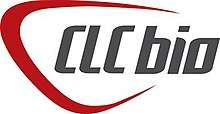CLC bio
CLC bio was a bioinformatics software company headquartered in Aarhus, Denmark, and with offices in Cambridge, Massachusetts, Tokyo, Taipei and Delhi. CLC bio's software has more than 250,000 users [1] in more than 100 countries around the globe. CLC bio was acquired by QIAGEN in 2013, and continues to exist as a part of QIAGEN Digital Insights, the bioinformatics research and development division of QIAGEN.
 | |
| Privately held company | |
| Industry | Bioinformatics |
| Founded | 2005 |
| Headquarters | , |
Area served | Denmark Cambridge, Massachusetts Tokyo Taipei Delhi |
| Products | Software and consulting |
| Website | http://www.clcbio.com |
Software
CLC bio develops widely cited[2] desktop[3], enterprise and cloud software for analysis of biological data. While offering some open source algorithms with their tools, CLC bio have their own implementations of several popular applications, which have been accelerated using SIMD technology. In 2010, CLC bio was the first commercial platform for bioinformatics analysis that utilized a graphical user interface for building, managing, and deploying analysis workflows[4].
Among other features, the software supports read mapping of Sanger and high-throughput sequencing data, de novo assembly of Sanger and high-throughput sequencing data, SNP detection on whole genomes of any size, detection of structural variations on whole genomes of any size, ChIP-seq analysis, RNA-Seq analysis, small RNA analysis and BLAST. CLC bio also provides additional plugins (both free and commercial) that extend the platform for use in specific subject areas including genome finishing, microbial genomics, and structural biology.
CLC bio's software allows the user to analyze, visualize, and compare genomic, transcriptomic, and epigenomic data from all major high-throughput sequencing platforms such as Illumina, Life Technologies, Roche 454, Pacific Biosciences, Oxford Nanopore, and Complete Genomics. CLC bio's software is platform independent and can be used for Mac OS X, Windows, and Linux. The platform includes both a desktop graphical user interface, command-line tools, a SOAP and REST API, and the ability to run containerized tools.
CLC bio's analysis platform has been installed at several of the world's research institutions and at more than 2000 different organizations[5] around the globe, including the top 10 pharmaceutical companies in the world.
Cloud Computing
In 2017, CLC bio launched their CLC Genomics Cloud Engine[6] as a command-line driven platform for cloud-based bioinformatics workflow execution on Amazon Web Services. In 2019, this platform was adapted for and approved for use in AWS GovCloud. In 2020, CLC bio released a free plug-in that enables workflow execution on AWS directly from the CLC Genomics Workbench desktop software.
Hardware
Early on, the company presented own-developed high-performance computing solutions, focusing on accelerating open source algorithms such as HMMER, Smith-Waterman and ClustalW, using FPGA technology. CLC bio is no longer developing their own hardware-based products.
About
CLC bio started commercial activities on January 1, 2005 headquartered in Denmark. It is a profitable, privately owned company with 100 employees and has been acquired by Qiagen in late 2013. 30% of the employees have a PhD and another 50% have a MSc.[7]
CLC bio maintains a scientific focus by initializing and participating in various research projects around the world, including multiple projects funded by grants.[8] [9]
References
- Number of users
- Google Scholar citations
- "QIAGEN CLC Genomics Workbench | QIAGEN Digital Insights". Bioinformatics Software and Services | QIAGEN Digital Insights. Retrieved 2020-05-07.
- "Latest Improvements". Bioinformatics Software and Services | QIAGEN Digital Insights. Retrieved 2020-05-07.
- List of customers
- "Latest Improvements". Bioinformatics Software and Services | QIAGEN Digital Insights. Retrieved 2020-05-07.
- "Company profile (PDF)" (PDF). Archived from the original (PDF) on 2012-05-04. Retrieved 2012-05-29.
- GenomeWeb
- GenomeWeb